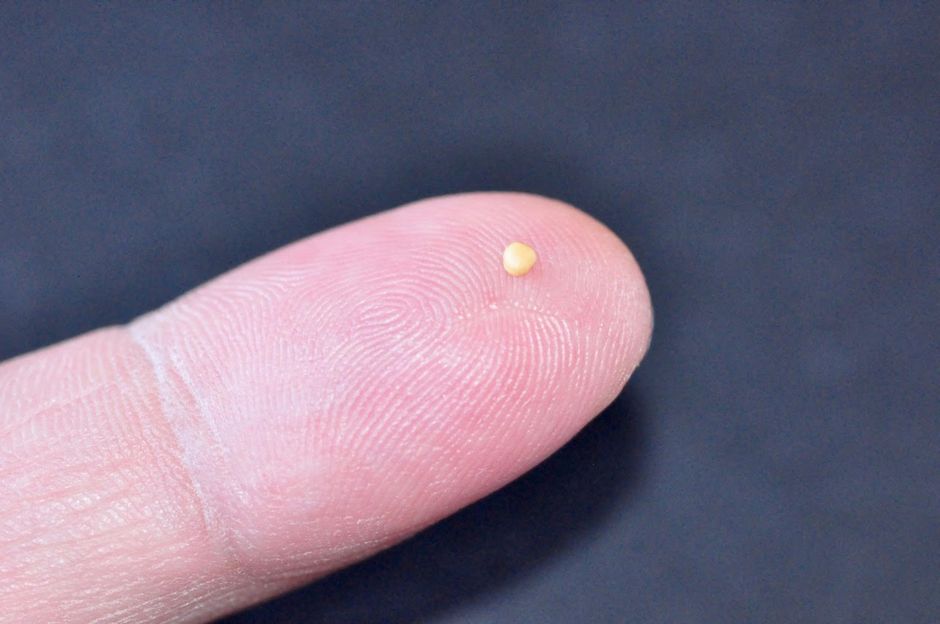Black mustard seed, as tiny as the head of a needle, is one of the smallest seeds that can be perceived by the naked human eye.
 White mustard seed (Brassica alba). / Photo: Antonio Cruz
White mustard seed (Brassica alba). / Photo: Antonio Cruz
He put another parable before them, saying, “The kingdom of heaven is like a grain of mustard seed that a man took and sowed in his field. It is the smallest of all seeds, but when it has grown it is larger than all the garden plants and becomes a tree, so that the birds of the air come and make nests in its branches.
(Mt. 13:31-32)
The Greek term, sínapi, is of Egyptian origin and refers to “mustard” (Mt. 13:13; 17:20; Mark 4:30-31; Luke 13:18-19; 17:6), whereas the word used for mustard is of Syrian origin, jardal. It is a plant that belongs to the Brassica species, of which there are four subspecies in Israel (Brassica cretica, B. rupus, B. tournefortii y B. nigra).
The latter type of mustard seems to be the one that is mentioned in the New Testament. In fact, black mustard has tiny seeds of only about a millimetre in diameter, but when they germinate, which happens very quickly, they soon become bushes reach a height of three or four metre, capable of sheltering the nests of finches and goldfinches. They used to be commonplace in Hebrew vegetable plots and gardens.
The black mustard bush is an annual herbaceous plant which is grown for its small spicy seeds, used to develop spices. It is believed to have originated in the Mediterranean region, though it spread throughout half the world. Now it is less common than the leaf mustard (B. juncea) or white mustard (B. alba), but it is still grown in India to make oils and sauces.
The flowers are pale yellow, and the fruit is a sheath of up to 2cm replete with reddish-brown seeds. The arial organs of the plant can be toxic for some people, as they contain glucosinolates. However, removed from their covering, the seeds are used, dried and ground, as a spice or to make mustard paste.
In Indian cuisine they are used to develop certain dishes such as curry or sambaar podi. In Europe, black mustard was introduced by the Romans, who gave it the Latin name mustum ardens, or “burning wort”, as they used to mix it with grape wort.
Black mustard seed, as tiny as the head of a needle, is one of the smallest seeds that can be perceived by the naked human eye. However, when it germinates it ends up becoming a bush which, growing as they do on the shores of lake Tiberias, can reach three or four metres in height. In the Iberian Peninsula this plant blossoms in its wild state; it belongs to the same family as kale, and is the source of the famous mustard sauce. In Spain, black mustard barely reaches a height of more than one metre, but in the Palestinian climate, as emerges from the pages of rabbinic literature, it can be as high as a fig tree. Thus, it is perfectly conceivable that small birds could build their nests in it. For Jews, mustard seeds were a symbol of smallness and insignificance.

The German theologian Joachim Jeremias said that “modern man goes out into the countryside and sees growth as a mere biological process. But the men of the Bible saw in the same process one divine miracle after another, resurrections from the dead” [1]. Yes indeed, this is true. But is the biological process not also a miracle? Is it not a mystery that seeds withstand the winder cold by dehydrating themselves, that is by reducing the water content of their cells by up to 10%? Why do they do so?
Is it not a miracle that they manage to survive by reducing their physiological cellular activity to always imperceptible levels? Who taught them to behave like this? Where did this intelligence come from? Is it not a prodigy of nature that there are seeds that can survive for more than a thousand years, in a state of dormant life, and then germinate, as happens to the Asian lotus flower (Nelumbo nucifera)?
Now science can tell us how these seeds can germinate, but not why they do so. Biology can explain to us how organisms work, but it cannot tell us why they work or how they began to. If anyone fails to see an intelligent plan and purpose in biological mechanisms and in their origin, it is because they have chosen to remain blind.
God chooses the humblest realities to bring his great design to fruition. The Lord does not need tall trees or large seeds. He chooses rather to exalt a “humble tree” and a tiny seed. For Jesus’s hearers, the tall tree was a common image of earthly power, but the Master is saying to them that from the simplest beginnings, out of something that is almost nothing in the eyes of men, God give birth to his kingdom; a kingdom which will develop and end up encompassing all the kingdoms of the earth. Minute beginnings a magnificent conclusion. Modest and insignificant appearances but a grand final reality.
Just as the mustard seed ends up becoming a leafy tree that provides shelter for the birds, the miracle of divine love will convert this little flock into the people of God, who will bring salvation to all the peoples of the earth.
[1] Jeremias, J. The parables of Jesus

Las opiniones vertidas por nuestros colaboradores se realizan a nivel personal, pudiendo coincidir o no con la postura de la dirección de Protestante Digital.
Si quieres comentar o